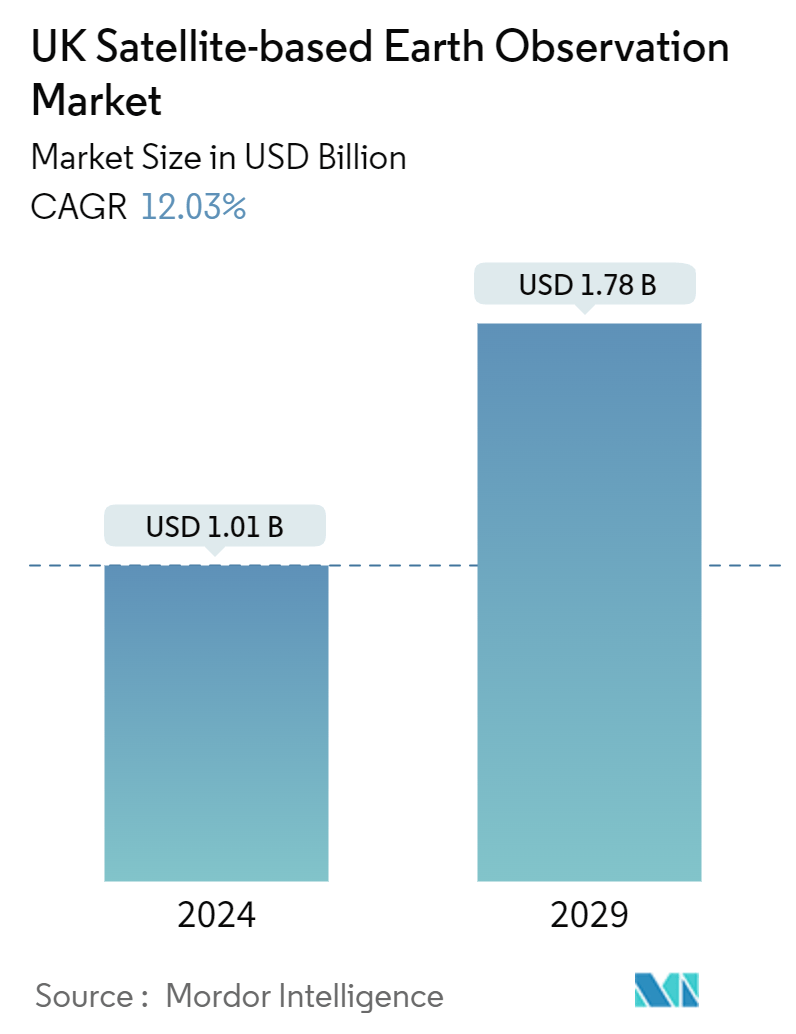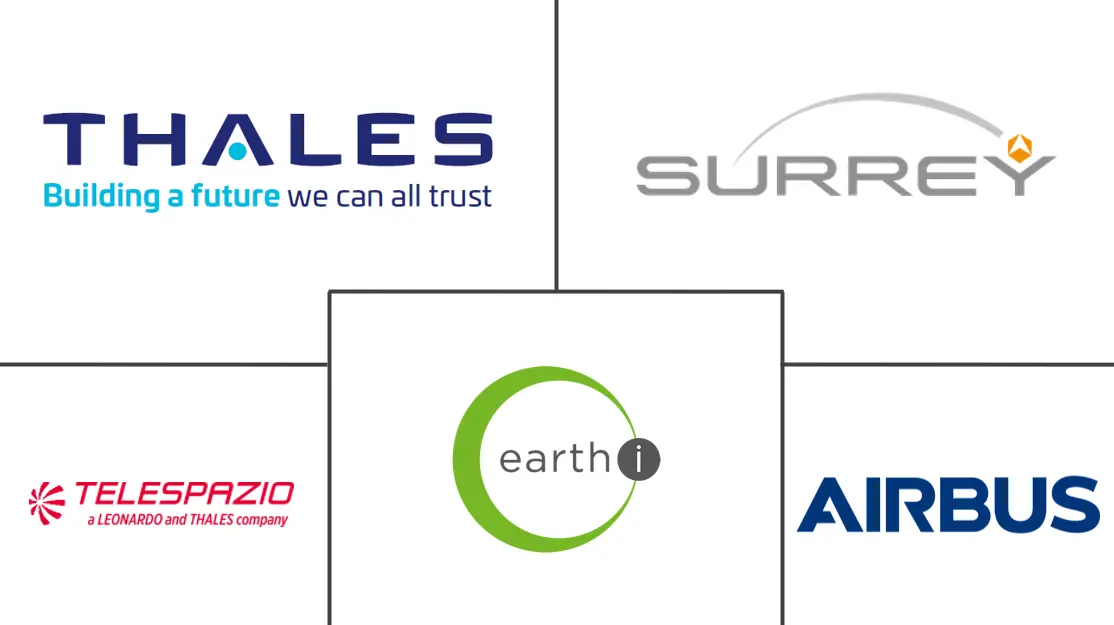Market Size of UK Satellite-based Earth Observation Industry

| Study Period | 2019 - 2029 |
| Base Year For Estimation | 2023 |
| Market Size (2024) | USD 1.01 Billion |
| Market Size (2029) | USD 1.78 Billion |
| CAGR (2024 - 2029) | 12.03 % |
| Market Concentration | Medium |
Major Players
*Disclaimer: Major Players sorted in no particular order |
UK Satellite-based Earth Observation Market Analysis
The UK Satellite-based Earth Observation Market size is estimated at USD 1.01 billion in 2024, and is expected to reach USD 1.78 billion by 2029, growing at a CAGR of 12.03% during the forecast period (2024-2029).
The growing concern over climate change and its impact on the environment and society is expected to drive the demand for satellite-based Earth observation data. Satellites can provide crucial information on weather patterns, greenhouse gas emissions, deforestation, and other climate-related parameters, enabling better understanding and decision-making to address climate change challenges.
- The United Kingdom is committed to addressing climate change and meeting its emissions reduction targets. Satellite data plays a vital role in monitoring greenhouse gas emissions, tracking changes in the atmosphere and oceans, assessing the health of ecosystems, and understanding climate patterns. This information helps scientists, policymakers, and businesses develop effective climate change mitigation and adaptation strategies.
- Further, the country is prone to various natural hazards, including floods, storms, and landslides. Satellite-based Earth observation plays a crucial role in monitoring and predicting these events, providing early warnings, assessing damage, and supporting emergency response efforts. By observing weather patterns, river levels, and terrain changes, satellites contribute to improved disaster preparedness, risk assessment, and efficient deployment of resources during emergencies.
- In addition, the government has actively promoted and supported satellite-based Earth observation initiatives through various programs and funding schemes. These initiatives aim to address environmental challenges, climate change mitigation, disaster management, and national security. Government support in the form of research grants, partnerships, and policy frameworks has helped drive the market's growth.
- Advances in satellite technology have significantly improved the quality and availability of Earth observation data. High-resolution sensors, enhanced data processing capabilities, and improved satellite constellations have expanded the scope and applications of satellite-based Earth observation. These technological advancements have driven market growth by enabling more accurate, detailed, and timely data collection.
- However, integrating satellite-based Earth observation data with other datasets or existing systems can be challenging due to differences in data formats, standards, and platforms. Lack of interoperability between various data sources and systems may limit satellite data's seamless integration and utilization in decision-making processes. Establishing data standards and promoting interoperability is essential for overcoming this constraint.
UK Satellite-based Earth Observation Industry Segmentation
Satellite-based earth observation is done with the help of satellites orbiting around the planet to view and identify environmental changes, map making, etc. The satellite-based earth observation technology captures and stores information from satellites relating to the physical, biological, and chemical compositions of the Earth for monitoring, surveillance, and decision-making in various verticals, such as defense and intelligence, infrastructure and engineering, natural resource management, energy and power, and disaster management.
The United Kingdom satellite-based earth observation market is segmented by type (earth observation data, value added services), satellite orbit (low earth orbit, medium earth orbit, geostationary orbit), and end-user (urban development and cultural heritage, agriculture, climate services, energy and raw materials, infrastructure). The market sizes and forecasts are provided in terms of value (USD) for all the above segments.
| By Type | |
| Earth Observation Data | |
| Value Added Services |
| By Satellite Orbit | |
| Low Earth Orbit | |
| Medium Earth Orbit | |
| Geostationary Orbit |
| By End-use | |
| Urban Development and Cultural Heritage | |
| Agriculture | |
| Climate Services | |
| Energy and Raw Materials | |
| Infrastructure | |
| Others |
UK Satellite-based Earth Observation Market Size Summary
The United Kingdom's satellite-based Earth observation market is poised for significant growth, driven by increasing concerns over climate change and the need for effective environmental monitoring. This market is expected to expand as satellite technology advances, providing high-resolution data that aids in understanding weather patterns, tracking greenhouse gas emissions, and assessing ecosystem health. The UK's commitment to meeting emissions reduction targets and addressing natural hazards like floods and storms underscores the importance of satellite data in disaster preparedness and response. Government initiatives, including research grants and policy support, further bolster the market by promoting the use of satellite-based solutions for environmental challenges, climate change mitigation, and national security.
The market's growth is also fueled by its applications in urban planning, infrastructure development, and cultural heritage preservation. Satellite-based Earth observation provides critical insights into land use patterns, urban growth, and infrastructure networks, supporting sustainable urban development. Additionally, it plays a vital role in monitoring and managing wildfires and disaster risk in urban areas. The UK's focus on smart city initiatives and resource management further highlights the relevance of satellite data. Key players in the market, such as Thales Group, Airbus Defence and Space, and Surrey Satellite Technology Ltd, contribute to its consolidation and innovation, supported by government funding and collaborative projects aimed at enhancing the capabilities and applications of Earth observation technologies.
UK Satellite-based Earth Observation Market Size - Table of Contents
-
1. MARKET INSIGHTS
-
1.1 Market Overview
-
1.2 Industry Attractiveness - Porter's Five Forces Analysis
-
1.2.1 Bargaining Power of Buyers
-
1.2.2 Bargaining Power of Suppliers
-
1.2.3 Threat of New Entrants
-
1.2.4 Threat of Substitutes
-
1.2.5 Intensity of Competitive Rivalry
-
-
1.3 Industry Value Chain Analysis
-
1.4 Assessment of the Impact of COVID-19 on the Market
-
-
2. MARKET SEGMENTATION
-
2.1 By Type
-
2.1.1 Earth Observation Data
-
2.1.2 Value Added Services
-
-
2.2 By Satellite Orbit
-
2.2.1 Low Earth Orbit
-
2.2.2 Medium Earth Orbit
-
2.2.3 Geostationary Orbit
-
-
2.3 By End-use
-
2.3.1 Urban Development and Cultural Heritage
-
2.3.2 Agriculture
-
2.3.3 Climate Services
-
2.3.4 Energy and Raw Materials
-
2.3.5 Infrastructure
-
2.3.6 Others
-
-
UK Satellite-based Earth Observation Market Size FAQs
How big is the UK Satellite-based Earth Observation Market?
The UK Satellite-based Earth Observation Market size is expected to reach USD 1.01 billion in 2024 and grow at a CAGR of 12.03% to reach USD 1.78 billion by 2029.
What is the current UK Satellite-based Earth Observation Market size?
In 2024, the UK Satellite-based Earth Observation Market size is expected to reach USD 1.01 billion.

